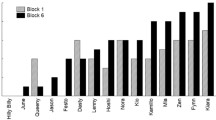Abstract
Dogs were used to condition two instrumental reactions—bending of the left or of the right forepaw respectively. In the experimental situation a dish containing food was presented to the dog at a distance but could be drawn close and retained by lifting the forepaw to which (left or right) a lever had been attached. If both paws were simultaneously attached to levers, the dog had to choose between two reactions. Preliminary trials showed a right paw preference in spite of the equal effectiveness (food reinforcement) of the left paw. The aim of this experiment was to alter this right paw preference by a paradigm of differential practice with left paw dominance. The plan was to have ten training sessions followed by one test with choice. According to the probabilities, Pleft = 0.8, Pright = 0.2, a random table was used to determine the order of the right-left paw attachments to the levers during training. In all, 1,000 training sessions and 100 tests with choice were carried out in each of three dogs. According to the training program, in every 100 training sessions the left paw had to perform the reaction a total of 80 times and 20 times by the right paw. An absolute alteration in paw preference occurred Plelt = 1.0) even though both forepaws were equally effective in obtaining food reinforcement on the test trials. The present results indicate that not only the Law of Effect but Exercise is also important in instrumental conditioning.
Similar content being viewed by others
References
Asratyan, E. A.: Conditioned reflex and present neurophysiology.J. “Higher Nervous Activity” 15, 2: 202–216, 1965 (Russ.).
Beritov, I. S.:Nervous Mechanisms of Behavior in Higher Vertebrates. U.S.S.R. Academy of Sciences Press, Moscow, 1961 (Russ.).
Bernstein, N. A.: Urgent Problems on the control of motoracts.J. “Problems of Psychology.” No.6:70. 1957 (Russ.).
Gassanowa, R. L., Iranova, N. I., Kozlowska, I, B.: On the analysis of functional structure of conditioned avoidance reactions.In: “Nervous mechanisms of motor activity.” Moscow, Nauka, 1965 p. 339.
Miller, G. A.:Plans and the structure of behavior. New York, Henry Holt Company, 1960.
Pavlov, I. P.: The reply of a physiologist to psychologists.Psychol. Rev. 39, 1932.
Skinner, B. T.:The behavior of organisms. An experimental analysis. New York, Appleton-Century Crofts, 1938.
Author information
Authors and Affiliations
Rights and permissions
About this article
Cite this article
Popova, E.I., Popova, E.I. The effect of exercise on the selective performance of an instrumental response. Pav. J. Biol. Sci. 14, 61–63 (1979). https://doi.org/10.1007/BF03001816
Issue Date:
DOI: https://doi.org/10.1007/BF03001816




